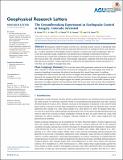The Groundbreaking Experiment in Earthquake Control at Rangely, Colorado, Revisited
Author(s)
Byrne, H; Silva, JA; Plesch, A; Juanes, R; Shaw, JH
DownloadPublished version (6.092Mb)
Publisher Policy
Publisher Policy
Article is made available in accordance with the publisher's policy and may be subject to US copyright law. Please refer to the publisher's site for terms of use.
Terms of use
Metadata
Show full item recordAbstract
©2020. American Geophysical Union. All Rights Reserved. Earthquakes caused by human activities are a growing societal concern. A pioneering study of induced seismicity in the 1970s involved cooperation between the U.S. Geological Survey and Chevron, Inc., to adjust operations in the Rangely oil field, Colorado, to initiate and control earthquakes. Here we revisit this experiment using coupled flow and geomechanical modeling to determine the physical mechanisms that caused these earthquakes and investigate the strength and state of stress acting on the fault that sourced them. The controlled nature of the Rangely experiment, combined with data from decades of field operations, presents a unique opportunity to understand the phenomenon of induced seismicity in ways that can be applied to manage these risks.
Date issued
2020-05Department
Massachusetts Institute of Technology. Department of Earth, Atmospheric, and Planetary Sciences; Massachusetts Institute of Technology. Department of Civil and Environmental EngineeringJournal
Geophysical Research Letters
Publisher
American Geophysical Union (AGU)
Citation
Byrne, H, Silva, JA, Plesch, A, Juanes, R and Shaw, JH. 2020. "The Groundbreaking Experiment in Earthquake Control at Rangely, Colorado, Revisited." Geophysical Research Letters, 47 (11).
Version: Final published version
ISSN
0094-8276
1944-8007